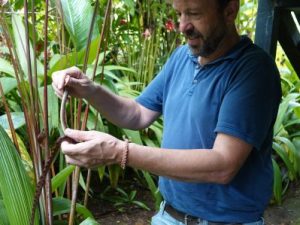
Family Adventures in Costa Rica
Family Adventures in Costa Rica A Guide to Kid-Friendly Activities Costa Rica is one of the most popular places to vacation for families because of
Snakes are captivating creatures and play an imperative role in the ecosystem, even poisonous ones. We humans can happily coexist with snakes if we understand their habits and respect their space.
The main reason people fear these slithery venomous reptiles is because we don’t know much about them except that they can be deadly. If you are thinking about traveling to Costa Rica or another tropical paradise but are worried about an encounter with a snake, the first thing to do is learn about them.
In this article we share insider tips and information about snakes from our snake experts. The best way to fully enjoy nature safely is to educate yourself.
Question
How often do people come across snakes in Costa Rica?
Answer
Our experts say that snakes love to hide and they typically bite defensively so you rarely see them. According to Marcus, “if you do see them, they are not interested in biting a much larger animal (us) that is clearly a danger to it, so the snake would rather hide or move away from us.”
Snakes are not just in the jungle, they are everywhere. Rainer shares a story about a woman who was bitten in a cafe in La Fortuna. When he called the hospital to check on her she was doing okay and said, “don´t worry, I am used to it, I was also bitten in Thailand!” Maybe snakes are drawn to certain people but we think you should always be aware.
The fer de lance or terciopelo is the most commonly encountered venomous snake and is reported to be responsible for around half of poisonous snake bites in Central America according to Toxicon on Science Direct.
Read more about the different types of snakes in Costa Rica.
Question
What are the most important safety measures I can take to avoid an accident with a snake?
Answer
“Normally when I go into nature”, says Paul, “always check before you touch a plant or tree and watch the ground while you are walking, and never wear sandals.” Paul also mentions that “if you have a guide, it is best to stay behind them as they will check for danger before you come through.”
Snakes like to hide in fallen trees and under leaves so always check before you sit or walk off a cleared trail. Rainer explains not to touch them and that “if you see one to walk back slowly or make a big circle around the snake to try and make the snake feel comfortable.” Markus reminds you “keep your eyes open, don’t pick them up or try to kill them, stay on the trails. Most importantly, always use a flashlight at night!”
Question
How do I tell the difference between a poisonous or venomous snake and a non-venomous snake?
Answer
There is not one thing that consistently tells them apart. Markus explains that it is important to keep in mind that snakes are different all around the world and may have characteristics that don’t necessarily follow these rules. Paul explains that it depends on the group of snakes, because in nature you find snakes with neurotoxic venom and hemolytic venom, so both groups have different characteristics.
Our experts have confirmed that the following rules apply the majority of the time for snakes in Costa Rica.

We believe you have some basic knowledge now, however, it is best to go into the jungle with a guide who can confirm any snake sightings and help keep you safe. Read up on their habits and see photos of the different types of snakes in Costa Rica.
Question
What are the most common myths or misconceptions about snakes?
Answer
Paul says that a lot of people think that all snakes are dangerous. While it is best to keep your distance, according to Markus, many snakes can’t harm you and do not want to have any contact with humans.
On the other hand, there is a belief that snakes are not dangerous because they disappear if you step on the ground. This is not true. According to Rainer, they often stand their ground which is why most bites come from accidently stepping on them.
Question
Is it true that during the wet season in Costa Rica, you are more likely to encounter snakes?
Answer
Paul says that at the beginning of the rainy season it is more common to find snakes. Markus explains that snakes are more active when it is easier for them to find food. In the wetter months there would be more frogs and other small vertebrates around for them to hunt.
Question
What should I do if I am bit by a snake? What symptoms might I experience?
Answer
“Keep calm and call 911 or get to a hospital as soon as possible,” says Rainer. According to Paul, “you may have symptoms such as dizziness, swelling, pain or bleeding in the affected area, loss of coordination, blurry vision. It is possible to lose a limb or die within a few hours. The severity depends on the amount of venom and size of the snake. Even if you are not feeling these symptoms, it is best to go to the hospital because there can be infections from bacteria.”
“It is good to know which snake you were bitten by,” says Markus, “so get a photo if you can, but don’t chase after it and get bitten again!” He also notes that different snakes have different venom which means the symptoms and treatment of the bite are different. Generally, it is recommended to move the bitten area as little as possible If there is someone else around it is better for them to go to get help if it was a dangerous snake.
Question
How close can I get to take a photo?
Answer
Your best option is to ask your guide. If you are without a guide, remember that snakes can move fast and some can lunge as much as half their body length. A general recommendation is to stay at least 6 feet away, however, our experts say 10-15 feet is a safer distance, especially if you are looking through a camera or at your phone screen.
Our expert, Markus, shares that during a tour he was guiding, they found a King Cobra on a road, seemingly struggling to get over a curb. One of the guests decided to get close to take a photo with her phone. As she walked closer and closer, only looking at her screen where everything always seems further away than it actually is, she was so focused that she didn’t hear me running towards her and screaming that she should stop and not go any closer. Thankfully, she did not get bitten but she was too close.

Rainer Stoll is from Germany and has been traveling and doing business in Costa Rica for nearly 30 years. He is one of the founders of a tourism agency, a travel planning agency, a rainforest reforestation project among others. Through the creation and management of these companies he has handled many snake encounters and aids in providing safe tours through Ecoterra, a large tour company in Costa Rica, for thousands of tourists each year. Rainer’s partner dislikes snakes so he definitely plays the role of protector when they are together in the jungle. His best tip is, “If you get bitten by a snake, pray and write down your last wishes… just kidding! Take a picture of the snake and go to the nearest hospital.”

Markus Lilje is a South African, now living in Germany. He worked as a field guide and tour leader in many countries around the world and has a lot of experience in dealing with tricky situations and challenges with tourists. Markus is passionate about showing all different aspects of the environment and trying to ensure that people feel more connected with the world around them, even with snakes and other species that many people don't understand or are afraid of.

Paul Valenciano is from Costa Rica and started his career in tourism as a guide more than 25 years ago and is now a manager for Ecoterra, a large tour company in Costa Rica. He grew up on a farm and has been bitten by numerous non-venomous snakes and nearly been bitten by terciopelos or the fer de lance. Paul's favorite story to tell is when he nearly stepped on one that was all coiled up sleeping and he jumped more than 2 meters in the air! Most sources say these beauties can get up to 2 meters in length but he has seen them up to 3 meters.
Whether adrenaline, nature or wildlife watching - pick the tour that suits you from our day trips.
.......
Explore a region with our ready-made building blocks and waste no more time planning your trip.
.......
Whether shuttle, private transport or rental car, we take care that you reach your destination safely and comfortably.
.......

Family Adventures in Costa Rica A Guide to Kid-Friendly Activities Costa Rica is one of the most popular places to vacation for families because of

Getting Around Costa Rica: A Guide to Transportation Options and Costs Costa Rica, known for its stunning landscapes, rich biodiversity, and vibrant culture, offers travelers

Poisonous Snakes Ask the Experts Snakes are captivating creatures and play an imperative role in the ecosystem, even poisonous ones. We humans can happily coexist
We are your contacts for a successful stay in Costa Rica and look forward to your inquiries: info@costaricainsider.com